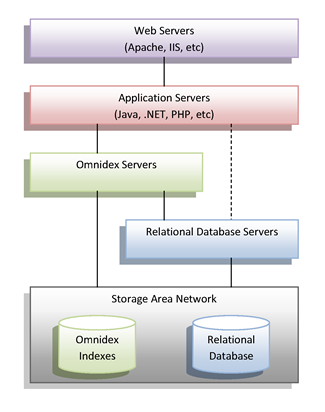Integration: Relational Databases
Overview | Servers | Environments | Queries | Updates | Integration Guides
Servers
Omnidex benefits from being on a separate server from the relational database whenever possible. Relational databases tend to use strategies that consume most of the resources on a server. It is not uncommon for a relational database to consume nearly all of the memory and CPU while processing large quantities of data using multiple threads. While this maximizes the performance of the relational database, it does not preserve many resources for other processes such as Omnidex.
Typically, Omnidex is placed on an Omnidex Server and the relational database is placed on a Relational Database Server. This allows each to utilize system resources as they need without interference from the other.
Applications can be written to direct all query traffic to Omnidex, or the application can split the traffic between Omnidex and the relational database. Applications that direct all query traffic to Omnidex simply switch the connections from the relational database to Omnidex. Applications that will split the traffic maintain concurrent connections to Omnidex and the relational database.
Most companies rely on a Storage Area Network (SAN) for accessing their data. Omnidex indexes will usually reside on the SAN as well, though this is not a requirement. High-quality SANs provide great flexibility and excellent performance, though it is important to insure sufficient cache in the SAN as well as a sufficient number of paths to the servers.
Additional Resources
See also:
